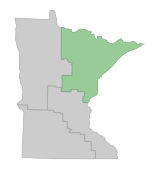
Aerial view of forest canopy showing mixed conifer-hardwood forest composed of white spruce, balsam fir, white cedar, paper birch, and quaking aspen.
The Northeast Region contains pristine lakes and extensive forests. It includes ten counties and some of the largest swaths of forests, lakes, and rivers in the state. The region includes two of the state’s four major ecological provinces: Eastern Broadleaf Forest of aspen, birch, oak, maple, and basswood in the southern counties transition to Laurentian Mixed Forest of aspen, birch, pine, spruce, fir and cedar in the northeastern counties of this region. It encompasses the Brainerd Lakes area, Big Sandy Lake, the lakes surrounding the city of Aitkin, the large state forests of Pine and Carlton counties, the widespread forests, and lakes north of Grand Rapids, the extensive bogs of Koochiching County, and the “Arrowhead Region.”

Regional highlights

Partial harvest systems that retain more live trees create more complex early successional forests with great habitat diversity for plants and animals.
Conserving rare species in managed forest landscapes
Minnesota's unique north shore
Large areas of the Northeast Region are managed intensively for timber production. If not implemented carefully this can lead to habitat degradation and even the loss of local plant populations or communities. The ecologists in the Northeast Region, utilizing the Natural Heritage Information System, do extensive surveys for rare plant species in areas where timber harvests are planned on state owned land. When rare species are located, we work with forest managers to develop plans in order to protect these plants and their habitats.
For most rare plant species, little is known about their biology, ecology, and life history traits. Our field work informs the collective knowledge of these species, allowing us to provide more effective forest management guidance.



Above, from left: Blunt-lobed grape fern often occurs adjacent to a seasonal wetland in a mature northern hardwood forest; Alpine Yarrow in flower; Braun's Holly Fern.

Butterwort Cliffs Scientific and Natural Area has a unique flora of plants adapted to the cool microclimate on the rocky shore adjacent to Lake Superior.
Minnesota’s unique North Shore
The North Shore of Lake Superior in Minnesota is a unique landscape. The shoreline is characterized by its gravel/cobble beaches and exposed bedrock features, as well as the rivers and streams that descend to Lake Superior from the highlands. The North Shore also includes a a mosaic of forested plant communities including northern hardwoods, mixed hardwoods and conifer, and lowland hardwood and conifer forests.
Lake Superior is unique in that it has a moderating influence on climate conditions. As a result the surrounding landscape has a longer growing season, warmer winters, and cooler summers. Due to the variety of microclimates in the near shore areas, they are home to unique plant communities and a number of rare plant species. The cool summer water temperatures provide habitat for plant species typically found in arctic or alpine climate zones including encrusted saxifrage, butterwort, Mistassini primrose, tufted bulrush, and spike Trisetum. Plant ecologists work with resource managers to protect habitats and rare species.



Above, from left: The Lake Superior shore in Tettegouche State Park; Rocks jutting into Lake Superior; Northern hardwoods and mixed conifer forests in the North Shore Highlands.

Old Growth Forest Network
The vast forests of the Northeast Region were heavily impacted by the intensive and extensive logging and subsequent catastrophic wild fires of the Euro-American settlement era (1850 – 1910). Prior to the settlement era, late successional forests, also known as Old Growth, covered more 50% of Minnesota’s forested landscapes.
Today only 5% of that Old Growth remains. Since 1910, short rotation, even-aged logging practices have continued to limit the development of old forests. In order to maintain representation of Old Growth, the Minnesota Department of Natural Resources maintains a network of Old Growth forest stands throughout the state. The Northeast Region contains 66% of these stands. Therefore, ecologists in the Northeast Region play a key role in conserving and monitoring Old Growth forest.




Above, from left: Regional Ecologist. Ryan Anderson, in Old Growth Grand Portage State Forest; White cedar trees in old growth forest showing the buttressed base characteristic of old growth trees; Standing dead and downed wood are key components of old growth forests. They help maintain biodiversity as they provide seedbeds for trees, and habitat for many organisms including birds, amphibians, invertebrates, fungi, and microorganisms.
Left: Old growth red pine-white pine forest on Minnesota point growing on stabilized sand dunes. Historically, this forest was maintained by indigenous people’s use of fire to maintain habitats.

Karen Updegraff
Regional Plant Ecologist

Ryan Anderson
Asst. Regional Ecologist

